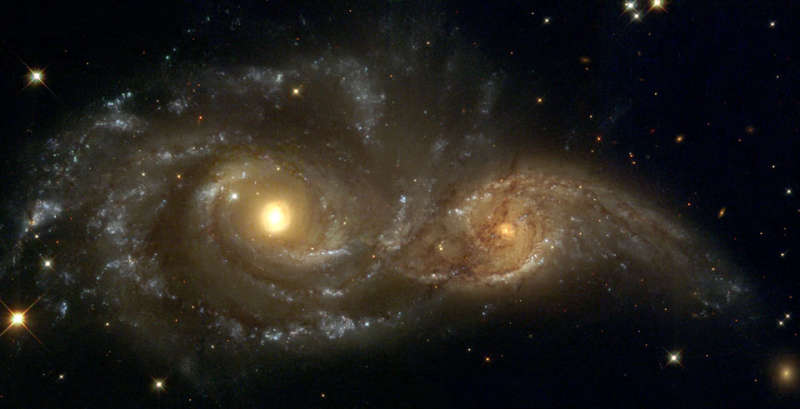Credit & Copyright: Debra Meloy Elmegreen
(Vassar College)
et al.,
& the Hubble Heritage Team (AURA/STScI/NASA)
Explanation:
Billions of years from now, only one of these two galaxies will remain.
Until then, spiral galaxies NGC 2207 and IC 2163 will slowly pull each other apart,
creating tides of matter, sheets of
shocked gas, lanes of
dark dust, bursts of
star formation, and streams of
cast-away stars.
Astronomers predict that NGC 2207, the larger galaxy on the left, will
eventually incorporate IC 2163, the smaller galaxy on the right.
In the most
recent encounter that about peaked 40 million years ago,
the smaller galaxy is swinging around counter-clockwise,
and is now slightly behind the larger galaxy.
The space between stars is so vast that when
galaxies collide,
the stars in them usually do not collide.
& the Hubble Heritage Team (AURA/STScI/NASA)
1999 2000 2001 2002 2003 2004 2005 2006 2007 2008 2009 2010 2011 2012 2013 2014 2015 2016 2017 2018 2019 2020 2021 2022 2023 2024 2025 |
Январь Февраль Март Апрель Май Июнь Июль Август Сентябрь Октябрь Ноябрь Декабрь |
NASA Web Site Statements, Warnings, and Disclaimers
NASA Official: Jay Norris. Specific rights apply.
A service of: LHEA at NASA / GSFC
& Michigan Tech. U.
|
Публикации с ключевыми словами:
interacting galaxies - взаимодействующие галактики
Публикации со словами: interacting galaxies - взаимодействующие галактики | |
См. также:
Все публикации на ту же тему >> | |
Мнение читателя [1]
